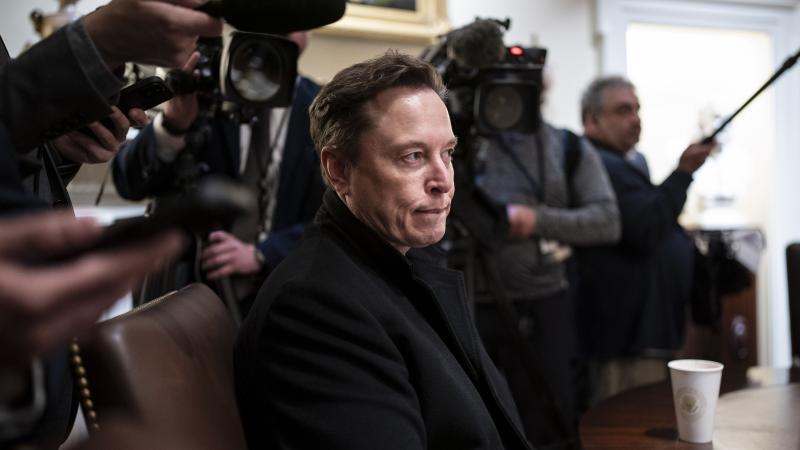Fossil fuels likely not going anywhere, despite fusion 'breakthrough' touted by Biden officials
Fusion technology is promising but years away from usefulness, according to experts, who added that investments in wind, solar, and electric vehicles aren't helping with the climate issue.
A future of nuclear fusion powering the country with limitless, carbon-free energy is promising but remains far out of sight, despite U.S. officials and scientists hailing what they described as a "breakthrough" in fusion technology, according to experts.
"There's a lot of hype and misreporting around this announcement," said Myron Ebell, director of the Center for Energy and Environment at the Competitive Enterprise Institute. "It's more an incremental advance than a breakthrough. Nuclear fusion research is very expensive and requires incredible amounts of energy and technology. This latest technological development is a significant step forward, but we're many decades away from having fusion power for powering our homes."
Federal researchers and Biden administration officials on Tuesday announced they created the first nuclear fusion reaction that generated more energy than was put into it to start the reaction.
"This is one of the most impressive scientific feats in the 21st century," Energy Secretary Jennifer Granholm said at a press conference in Washington. "America has achieved a tremendous scientific breakthrough."
Granholm added that this "landmark achievement" will "go down in the history books."
Scientists from Lawrence Livermore National Laboratory, a federal research facility, used lasers to combine hydrogen atoms into helium, mimicking the fusion reaction that powers the sun and stars. While this process may hold the key to a clean and potentially limitless energy source without the risk of radioactive waste, researchers had been unable to conduct fusion experiments that generated more energy than they consumed — until this month.
Specifically, the latest fusion experiment conducted last week and unveiled on Tuesday put in 2.05 megajoules of energy and resulted in an output of 3.15 megajoules, meaning there was a net gain of energy from the reaction, officials said.
However, this calculation didn't account for the significant amount of energy needed to power the lasers operating the fusion reactor. In this case, 300 megajoules needed to be drawn from the electrical grid to operate the lasers, according to Lawrence Livermore officials who spoke at the press conference.
In other words, even though the fusion reaction itself produced more energy than it consumed, the reaction couldn't have been conducted in the first place without exponentially more power from what could be called the experiment's wall-socket energy.
"So, there are many, many steps that have to be made in order to get to inertial fusion as an energy source," Mark Herrmann, program director for weapon physics and design at Lawrence Livermore, told reporters.
Still, President Biden has a decadal vision, to get to a commercial fusion reactor within 10 years," Granholm said Tuesday. "This shows that it can be done."
Fusion researchers say the earliest viable fusion reactors could come online would be 2040. Other experts argue fusion is unlikely to play a major role in power production before the 2060s or 2070s.
"There are very significant hurdles, not just in the science, but in technology," Kim Budil, director of Lawrence Livermore, said at Tuesday's event. "A few decades of research on the underlying technologies could put us in a position to build a power plant."
Another issue is price, as tritium, one of the key isotopes for fusion reactions, is among the most expensive substances on earth.
Money could factor in the progress of nuclear fusion in another way, according to Ebell, who explained government scientists are "getting worried" that private researchers might be making faster progress as companies raise large sums of money to work on this issue privately.
"What's the purpose of all this hype from Lawrence Livermore and the Energy Department?" he asked. "They need a lot more money for this research, and showing Congress and the public they're making progress is the way to do that."
Ebell wasn't alone in raising the potential motivation of funding.
"I'm skeptical of surprisingly well-timed announcements by budget-starved laboratories about breakthroughs for technologies decades away," tweeted Javier Blas, energy and commodities columnist for Bloomberg.
Despite the issues of price and timeframe, nuclear fusion research, which dates back to the 1950s, has bipartisan support and is considered by many the "holy grail" of clean energy. Biden administration officials have framed the development of fusion energy as a way to combat climate change.
However, the expected, decades-long delay in nuclear fusion becoming a serviceable source of power means fossil fuels are likely here to stay as wind and solar power and electric vehicles (EVs) — all priorities of the Biden administration as well — have done little to change global energy production patterns despite receiving massive investments.
As fusion makes progress, it could replace wind, solar, and EVs — all three of which, according to Ebell, aren't particularly effective anyway.
"It's a huge waste of money to invest in wind, solar, and electric vehicles," he said. "It's like playing whack-a-mole to stop climate change."
Proponents argue renewable energy is essential to transition away from fossil fuels, which they say aren't sustainable due to their greenhouse emissions and other environmental impacts.
The Biden administration has touted various programs to invest heavily in wind, solar, and EVs. However, the past decade has shown major spending on renewable energy hasn't led to less use of fossil fuels.
"At the end of last year, fossil fuels represented 81% of overall energy consumption. Ten years ago, they were at 82%" Jeffrey Currie, global head of commodities research at Goldman Sachs, said in October. "$3.8 trillion of investment in renewables [during that time] moved fossil fuels from 82% to 81% of the overall energy consumption."
Critics cite another problem with some of these renewable alternatives to fossil fuels: Much of the manufacturing, particularly with solar panels, comes from China.
"We should treat [nuclear fusion] like the hydraulic fracking technology that our private sector has very carefully guarded in recent decades," Victoria Coates, a senior official in the Trump White House, told the John Solomon Reports podcast. "That can be done in a way to keep it out of the hands of the Chinese and not put our energy security at their mercy. This seems to be a real strategic potential leap forward for us and our allies, and it would be great for the world. But it's something we have to guard as a national security issue."
Ebell agreed that nuclear fusion, while expensive, could be a gamechanger, but questions remain.
"You can't predict technological innovation, but fusion has the promise of providing a whole lot more energy for longer periods than the technology we have now," he said. "The question is: How long will it take to overcome the immense technological hurdles, how much it might cost to make it commercially feasible. But this is not going to solve the climate issue. Again, this is many decades away."
















